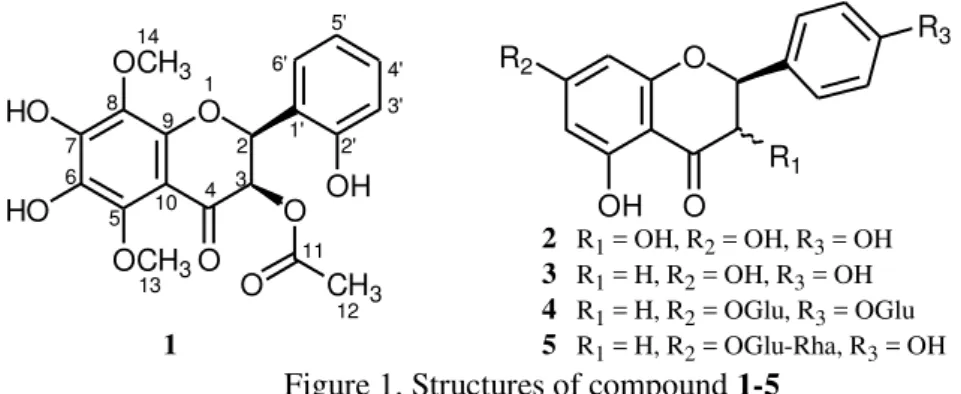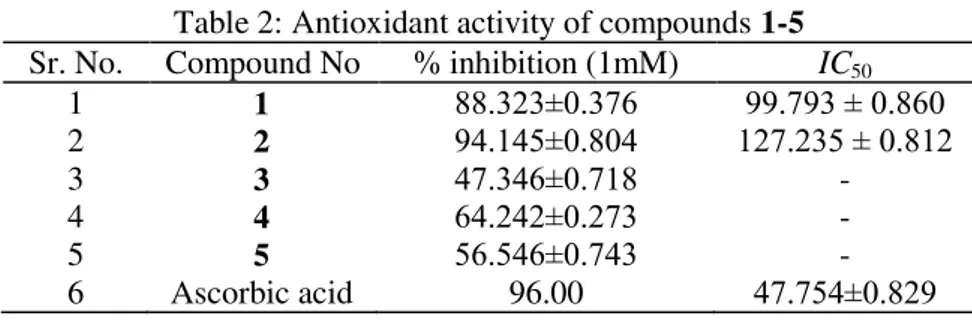The article was published by Academy of Chemistry of Globe Publications www.acgpubs.org/RNP © Published 06/01/2015 EISSN:1307-6167
Rec. Nat. Prod. 9:4 (2015) 567-571
Antioxidant Flavonoids from
Nepeta floccosa
Benth.
Liaqat Ali
*1, Samina Ali
2, Tania Shamim Rizvi
1, Abdul Latif Khan
1,
Zahid Hassan
1, Ahmed Al-Harrasi
1,3, and Javid Hussain
*1,31
UoN Chair of Oman’s Medicinal Plants and Marine Natural Products, University of Nizwa, P. O. Box 616, Nizwa, Oman
2
Department of Chemistry, Kohat University of Science and Technology, Kohat-26000, Pakistan
3
Department of Biological Sciences and Chemistry, College of Arts and Sciences, University of Nizwa, P. O. Box 616, Nizwa, Oman
(Received September 18, 2014; Revised March 14, 2015; Accepted January 17, 2015)
Abstract: Antioxidants are the substances which significantly delay or prevent the development of age-related degenerative and chronic diseases caused by oxidative damage. Due to this, there is a considerable interest in the identification of lead molecules, which can inhibit the oxidation process or slow it down considerably. Based on the spectrofluorimetric analysis of superoxide and diphenylpicrylhydrazyl radical scavenging ability, the bio-assay guided isolation of methanolic extract of Nepeta floccosa Benth. was carried out. As a result of this study, one new flavanonol named nepetavanol (1) and four known flavonoids; dihydrokaempferol (2), naringenin (3), caulesnarinside (4), and poncirin (5) have been isolated. The structure of the new flavanonol was assigned on the basis of 1H- and 13C-NMR spectra including two-dimensional NMR techniques such as COSY, HMQC, and HMBC experiments and FABMS, EIMS, HR-MS data. Compound 1, 2, and 3 showed significant activity whereas compounds 4 and 5 showed moderate activity against antioxidant assays.
Keywords: Flavonoids; Structure Elucidation;Lamiaceae; Antioxidant Activity.
1. Plant Source
The genus Nepeta belongs to the family Lamiaceae which comprises around 250 species mainly distributed in Asia, Europe, North America, North Africa, and Himalaya in India [1,2]. The plant, N. floccosa Benth., was collected at the Parachinar Kurram Agency, Khyber Pakhtunkhwa, Pakistan, in 2009, and was identified by Mr. Muhammad Siraj (plant taxonomist) at the Department of Botany, Govt. Jehanzeb Post Graduate College, Saidu Shareef, Swat, Pakistan. A specimen of this plant was deposited in the Herbarium of the College.
2. Previous Studies
For centuries plants have been used in folk medicine throughout the world. Many of the Nepeta species are used to treat dysentery, kidney and liver diseases, and teeth troubles in traditional medicines. Some species are reported to be diuretic, diaphoretic, vulnerary, antispasmodic, antiasthmatic, febrifuge and sedative [3-6]. There are also some reports about the effects of Nepeta species to maintain and balance the serum lipids and also against inflammations [7,8].
*
3. Present Study
In the course of phytochemical studies of medicinal plants [9-11], we investigated Nepeta floccosa Benth. (Lamiaceae) and thus reports on the purification and structure elucidation of one new flavanonol, nepetavanol (1), and four known flavonoids (2-5) in the present paper. The DPPH free radical scavenging assay was used for the evaluation of antioxidant potential of the purified constituents of the medicinal plant.
The methanolic extract of Nepeta floccosa Benth. (50 g) was subjected to chromatographic separations by increasing polarity order of dichloromethane and acetone, which yielded four known flavonoids; dihydrokaempferol (2, 12.5 mg), naringenin (3, 7.6 mg), caulesnarinside (4, 25.3 mg), and poncirin (5, 7.9 mg) along with some semi-pure sub-fractions (1-10). The semi-pure sub-fraction-8 obtained at 40 % acetone-dichloromethane yielded compound 1 (11.5 mg) by purifying on preparative plates using n-hexane-ethyl acetate (55:45). To the best of our knowledge this is the first report of all these flavonoids from N. floccosa Benth. The structure elucidation of the known compounds (2-5) was carried out by comparison of the reported NMR and MS data [12-15] of these compounds (Figure 1).
O O OH CH3 O OCH3 OCH3 HO HO O 1 2 3 4 5 6 7 8 1' 2' 3' 4' 5' 6' 1 O R1 OH R2 O R3
2 R1 = OH, R2 = OH, R3 = OH
3 R1 = H, R2 = OH, R3 = OH
4 R1 = H, R2 = OGlu, R3 = OGlu
5 R1 = H, R2 = OGlu-Rha, R3 = OH
9 11 12 10 13 14
Figure 1. Structures of compound 1-5
The IR spectrum of compound 1 exhibited bands at 3595 (OH), at 1732 (-COO-), 1695 (C=O), and 1590 cm-1 (C=C). The UV spectrum showed absorption maxima at 340 and 264 nm, which indicated the flavonoid skeleton in the molecule [16]. The FAB-MS spectra showed pseudo molecular ions at m/z 391 [M + H]+ and at m/z 389 [M - H]-, consistent with a molecular formula C19H18O9. The
molecular formula C19H18O9 was further confirmed through HR-FAB-MS, which showed the quasi
molecular ion at m/z 389.1025 [M - H]-. The EI-MS exhibited an ion at m/z 330 [M - 60]+, which resulted from the loss of acetic acid unit from the molecule, indicating the presence of acetyl moiety. The other prominent fragments in the EI-MS spectrum were observed at m/z 299 and 268, corresponding to further loss of two consecutive -OCH3 groups.
Table 1. 1H and 13C NMR data (300 and 75 MHz; CD3OD) and HMBC correlations for compound 1 (
in ppm, J in Hz).
No. δ(C) δ(H) HMBC
H–C(2) 79.4 3.56 (d, J = 2.1 Hz, 1H)
H–C(3) 74.9 3.66 (d, J = 2.1 Hz, 1H) C(11)
C(4) 180.3
C(5) 147.5
C(6) 133.6
C(7) 146.1
C(8) 138.5
C(9) 149.1
C(10) 104.2
C(11) 175.7
Me–C(12) 24.2 1.88 (s, 3H) C(3), C(11)
MeO–C(13) 56.5 3.79 (s, 3H) C(4), C(5), C(6)
MeO–C(14) 56.4 3.77 (s, 3H) C(2), C(7), C(8)
C(1′) 130.0 C(2′) 160.8
H–C(3′) 115.2 6.69 (dd, J = 8.3, 1.8 Hz, 1H) C(2´), C(4´) H–C(4′) 132.3 6.73 (t, J = 8.3 Hz, 1H) C(3´), C(5´) H–C(5′) 123.6 6.65 (t, J = 8.3 Hz, 1H) C(4´), C(6´) H–C(6′) 126.5 7.80 (d, J = 6.8 Hz, 1H) C(1´), C(5´)
The NMR spectra of 1 showed the presence of one acetate and two methoxy groups, whereas the presence of three hydroxyl groups could be inferred from the molecular formula C19H18O9. The
attachments of various functional groups in 1 were assigned on the basis of HMBC correlations (Figure 2). The HMBC correlations of H-3 and COMe H-atoms to COMe C=O group at δ 175.7, COMe H-atoms to C-3 at δ 74.9, and the OMe groups’ correlations (5-OMe H-atoms to C-4, C-5, and C-6; 8-OMe H-atoms to C-2, C-7, and C-8) confirmed the positions of these groups in the molecule. The substitution pattern on the two aromatic rings was thus established and the structure of 1 was further confirmed from correlations observed in COSY and HMQC experiments. The relative stereochemistry was deduced on the basis of J values and the NOESY interactions. The 1H-1H NOESY interactions of H-2 to H-3 were helpful in assigning the relative stereochemistry of C-2 and C-3 and consequently, compound 1 was confirmed as 3-O-acetyl-6,7,2′ -trihydroxy-5,8-dimethoxyflavanone, named nepetavanol (1) after the producing organism, Nepeta floccosa.
Nepetavanol (1): yellow amorphous powder. []D 30
= +14.5 (c = 0.04, MeOH). UV max
(CH3OH): 340, 264 nm. IR max (CH3OH): 3595, 2921, 1695, 1590, 1465 cm -1
. 1H-NMR (300 MHz, CD3OD), see Table 1.
13
C-NMR (75 MHz, CD3OD), see Table 1. EI-MS: 330 (M - CH3COOH) +
, 299 (M - CH3COOH - OCH3)
+
, 268 (M - CH3COOH - OCH3 - OCH3) +
. FAB-MS: 391 (M + H)+; 389.2 (M - H)-. HR-FAB-MS: 389.1025 ([M- H]-, C19H17O9; calc. 389.1029).
The purified compounds 1-5 were subjected to antioxidant assays. Free radical scavenging activities of the test samples were determined by measuring the change in absorbance of DPPH (l,l-Diphenyl-2-picrylhydrazyl radical) by the spectrophotometric method described by S. K. Lee [18]. After incubation at 37 °C for half an hour the yellow colored reduced form of DPPH, l,l-diphenyl-2-picrylhydrazine, is produced. The absorbance of the resulting solution was then measured at 562 nm and the scavenging activities (%) were calculated by using the following formula:
% RSA = [100-(AS/AC * 100)]
O
O OH
CH3 O
OCH3
OCH3
HO
HO
O H
Figure 2. Key HMBC interactions for compound 1.
Among all the compounds, compounds 1 and 2, isolated from N. floccosa, showed significant antioxidant activity (IC50= 99.793 ± 0.860, and 127.235 ± 0.812, respectively), whereas compounds 3,
4, and 5 showed moderate activity. Ascorbic acid (IC50 = 47.754 ± 0.829) was used as a standard
(Table 2). The results indicated that the antioxidant activity of the isolated flavonoids strongly depend on the positions and the number of oxygenated substituents. Compound 1 and 2 have more number of oxygenated functional groups; and are more liable to stabilize the DPPH free radical by donating more hydrogen; thus increasing the antioxidant activity.
Table 2: Antioxidant activity of compounds 1-5
Sr. No. Compound No % inhibition (1mM) IC50
1 1 88.323±0.376 99.793 ± 0.860
2 2 94.145±0.804 127.235 ± 0.812
3 3 47.346±0.718 -
4 4 64.242±0.273 -
5 5 56.546±0.743 -
6 Ascorbic acid 96.00 47.754±0.829
Acknowledgments
The authors acknowledge the assistance of Mr. Muhammad Siraj (plant taxonomist) at the Department of Botany, Govt. Jehanzeb Post Graduate College, Saidu Shareef, Swat, Pakistan for help in the collection and identification of the plant.
References
[1] J.D. Hooker (1975). Flora of British India, vol. 4. L. Reeve & Co., London, UK.
[2] Anonymous (1969). The Wealth of India, Raw Materials. Publication and information directorate, CSIR, New Delhi.
[3] K.H.C Baser, N. Kirimer, M. Kurkcuoglu and B. Demirci (2000). Essential oils of Nepeta species growing in Turkey, Chem. Nat. Compd.36, 356-359.
[4] M. Dabiri and F. Sefidkon (2003). Composition of essential oil of Nepeta crassifolia Boiss Buhse, Flav. Fragr. J.18, 225-227.
[5] A. Rapisarda, E.M. Galati, O. Tzakou, M. Flores and N. Miceli (2001). Nepeta sibthorpii Bentham (Lamiaceae): Micromorphological analysis of leaves and flowers, Farmaco56, 413-415.
[6] A. Zargari (1990). Medicinal Plants 4, Tehran University Publications, Tehran, Iran.
[8] S.A. Prokopenko and A.V. Spiridonov (1985). Betulin from Transcaucasian clover (Nepeta), Farm. Zhurnal.6, 70.
[9] L. Ali, T.S. Rizvi, M. Ahmad and F. Shaheen (2012). New iridoid glycoside from Gratiola officinalis,
J. Asian Nat. Prod. Res.14, 1191-1195.
[10] J. Hussain, N. Begum, H. Hussain, F.U. Khan, N. Rehman, A. Al-Harrasi and L. Ali (2012). Ajuganane: a new phenolic compound from Ajuga bracteosa, Nat. Prod. Commun.7, 615-616.
[11] J. Hussain, N. Rehman, H. Hussain, A. Al-Harrasi, L. Ali, T.S. Rizvi, M. Ahmad and Mehjabeen (2012). Analgesic, anti-inflammatory, and CNS depressant activities of two new constituents of Nepeta clarkei, Fitoterapia83, 593-598.
[12] J. Kang, Z. Li, T. Wu, G.S. Jensen, A.G. Schauss and X. Wu (2010). Anti-oxidant capacities of flavonoid compounds isolated from acai pulp (Euterpe oleracea Mart.), Food Chem.122, 610-617.
[13] A. Mahrooz, M.R. Rashidi and M. Nouri (2011). Naringenin is an inhibitor of human serum paraoxonase (PON1): an in vitro study, J. Clin. Lab. Anal.25, 395-401.
[14] S.-X. Zhang, T. Tani, S. Yamaji, C.-M. Ma, M.-C. Wang, S.-Q. Cai and Y.-Y. Zhao (2003). Glycosyl flavonoids from the roots and rhizomes of Asarum longerhizomatosum, J. Asian Nat. Prod. Res.5, 25-30.
[15] J.H. Lee, S.H. Lee, Y.S. Kim and C.S. Jeonq (2009). Protective effects of neohesperidin and poncirin isolated from the fruits of Poncirus trifoliata on potential gastric disease, Phytother. Res. 23, 1748-1753.
[16] J.F. Stevens, E. Wollenweber, M. Ivancic, V.L. Hsu, S. Sundberg and M.L. Deinzer (1999). Leaf surface flavonoids from Chrysothamnus,Phytochemistry51, 771-780.
[17] S.P. Shrestha, Y. Narukawa and T. Takeda (2007). Chemical constituents of Nepalese propolis (II),
Chem. Pharm. Bull.55, 926-929.
[18] S.K. Lee, Z . H . Mbwambo, H . Chung, L . Luyengi, E . J . Gamez, R . G . Mehta, D. Kinghorn and J.M. Pezzuto (1998). Evaluation of the anti-oxidant potential of natural products, Comb. Chem. High Throughput Screen. 1, 35-46.


